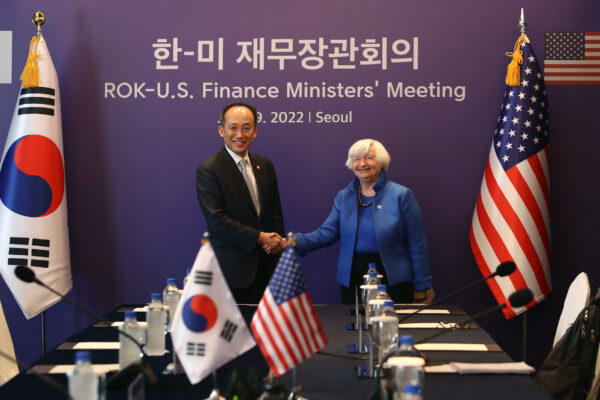Is South Korea Asia’s Canary in the Coal Mine?
Commentary
The expression used in the title conveys a sense of foreboding and early warning of trouble. It comes from the time before electronic sensory equipment when coal miners used these fragile birds to warn them of the presence of deadly methane gas in the mine shaft. If the bird collapsed, the miners had an early warning of extreme danger.
Now comes news of declining South Korean exports to the United States, Europe, and China and the strong likelihood that this important Asian economy has entered recession for the first time since the COVID-19 pandemic.
In February, the most recent period for which complete data are available, all South Korean exports stood some 15 percent below year-ago levels. Sales to China fell some 30 percent below year-ago levels, a hint that the Chinese industry is not operating at full capacity. Exports of semiconductors stand almost 50 percent below year-ago levels, a powerful hint that global activity has slowed. The nation’s index of factory activity stood at 48.5 in February, well below the level of 50 that demarcates between growth and contraction.

South Korea’s finance minister, Choo Kyung-ho, blamed the shortfall on the length of the Lunar New Year holiday in China and sharp declines in export prices, especially for computer chips. But the shortfall clearly goes deeper. Price declines in this once highly sought-after product can only reflect a global drop in demand.
In recognition of this reality, South Korean government sources are already forecasting a 4.5 percent drop in all that country’s exports for 2023 as a whole, quite a change from the 6.1 percent growth of 2022. Those sources also concede that South Korea’s economy contracted during the fourth quarter of last year and is on target to do the same during this year’s first quarter, effectively that it is in recession.
If the canary is not yet dead, this is a bad sign for Asia’s export-oriented economies, perhaps especially China’s. Taiwan and Malaysia, both big producers of semiconductors, have already seen overall declines in their exports. Japan reports that its index of factory activity came in at 48.6 in February, the most recent period for which complete data are available, up slightly from January but still in contractionary territory. Indeed, Japan has not seen a positive reading on this statistic in over a year. Toru Nishihama, chief economist for Dai-ichi Life Research Institute in Tokyo, points directly to “weakness in major export destinations like the United States and Europe” as the cause.
China has not entirely escaped this trend. Some hope of strength emerged when Beijing abandoned its zero-COVID lockdowns and quarantines and opened the nation’s economy in January. And in response, there has been a surge in consumer spending, what the media refers to as “revenge spending.” In reflection, China’s official index of factory activity did lift into expansionary territory with a 52.6 reading in February, the most recent period for which complete data are available.
But there is reason to doubt the strength implied by this figure. For one, consumer spending has occurred almost entirely among luxury goods and services, suggesting that it might not have the staying power required to propel the overall economy. For another, the official factory activity index has a narrow base. It focuses almost exclusively on large, state-owned firms. The broader, independent Caixin index shows much less impressive gains and, as of February, stood at 51.6. More ominously, China’s exports in January and February remain almost 7 percent below year-ago levels.
With the central banks of Europe and the United States lifting interest rates and constraining credit flows, export prospects for South Korea, China, and Asia generally look limited at best, even if the West avoids outright recession. Unless “revenge spending” redoubles in China—hardly likely—Beijing will almost surely have to revise the already reduced 5.0 percent forecast for real growth in 2023.
Views expressed in this article are the opinions of the author and do not necessarily reflect the views of The Epoch Times.




